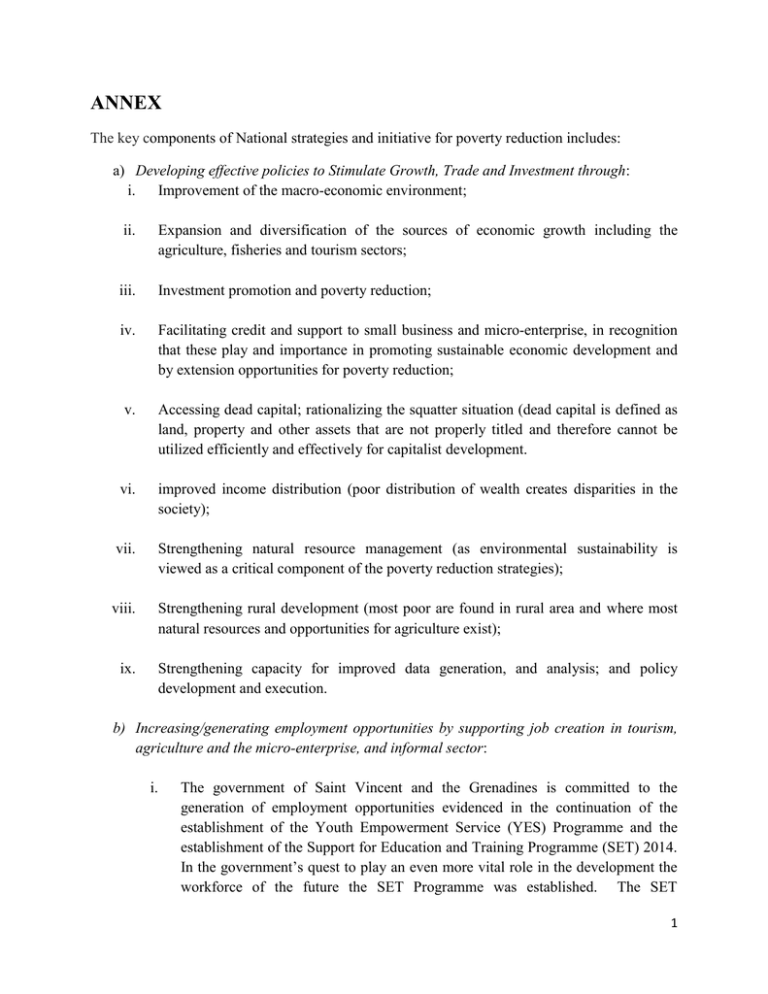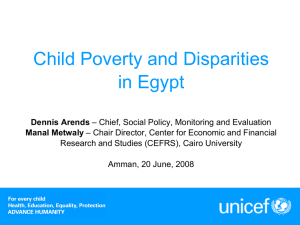ANNEX
advertisement

ANNEX The key components of National strategies and initiative for poverty reduction includes: a) Developing effective policies to Stimulate Growth, Trade and Investment through: i. Improvement of the macro-economic environment; ii. Expansion and diversification of the sources of economic growth including the agriculture, fisheries and tourism sectors; iii. Investment promotion and poverty reduction; iv. Facilitating credit and support to small business and micro-enterprise, in recognition that these play and importance in promoting sustainable economic development and by extension opportunities for poverty reduction; v. Accessing dead capital; rationalizing the squatter situation (dead capital is defined as land, property and other assets that are not properly titled and therefore cannot be utilized efficiently and effectively for capitalist development. vi. improved income distribution (poor distribution of wealth creates disparities in the society); vii. Strengthening natural resource management (as environmental sustainability is viewed as a critical component of the poverty reduction strategies); viii. Strengthening rural development (most poor are found in rural area and where most natural resources and opportunities for agriculture exist); ix. Strengthening capacity for improved data generation, and analysis; and policy development and execution. b) Increasing/generating employment opportunities by supporting job creation in tourism, agriculture and the micro-enterprise, and informal sector: i. The government of Saint Vincent and the Grenadines is committed to the generation of employment opportunities evidenced in the continuation of the establishment of the Youth Empowerment Service (YES) Programme and the establishment of the Support for Education and Training Programme (SET) 2014. In the government’s quest to play an even more vital role in the development the workforce of the future the SET Programme was established. The SET 1 Programme is designed to provide recent graduated of universities and the Saint Vincent and the Grenadines Community College with relevant work experience through assignments in the Public Service, Statutory Corporation or NGOs. c) Greater and better investment in human capital, particularly in the following areas: i. Education – The government of Saint Vincent and the Grenadines has identified education as a main indicator of poverty realizing that with the demands for increased productivity and a need for diversification of the economy, an educated populace is therefore a necessity. The government of Saint Vincent and the Grenadines regards education, first and foremost, as a social institution indispensable for quality production, order, progress, poverty reduction, and the development of individuals and society. It has thus, through the Ministry of Education developed the Education Sector Development Plan. This plan is the outcome of extensive discussions and consultations with a wide range of stakeholders in the sector throughout Saint Vincent and the Grenadines and is geared towards providing overall direction for the development of education in Saint Vincent and the Grenadines. The government has also recognised that quality education leads to greater employability. Thus programmes are geared towards strengthening the preschool system, providing adult education programmes, providing support to compulsory education strategies, exploring possibilities of a phased in approach to compulsory education, provision of technical and vocational training for youth, and reintroduction of agricultural science programmes in schools. ii. Health – Most programmes are geared towards the poor because they are at greater risk of illness and disease, less likely to report illness and a greater percentage is subjected to hospitalization and longer hospital stays. There is a thrust to upgrade and increase health care facilities throughout the country. iii. Social Service delivery – capacity building : This component of the strategy seeks to develop the capacity of various agencies involved in social service delivery, enabling them to identify strategic programmes in the development of human/social capital. Additionally, the institutional strengthening of the Ministry of National Mobilisation, Social Development, The Family, Persons with Disabilities, Youth, Sports and Culture is seen as a vital element; another is the strengthening of NGOs and Community Based Organisations to function at a community level. iv. Social protection and coping strategies – These include the development of an expanded Basic Needs Programme which provides emergency support to the needy and development of labour intensive public works projects which provide employment for the poor. In addition, there is a programme to prevent and address 2 domestic violence and another to developing non-contributory Pension programmes for the elderly. v. Agriculture – Poverty appears to be greater in rural areas, those most dependent on agriculture for their livelihood. Agricultural improvement will include programmes to combat praedial larceny, restructuring land tenure practices to enable greater access to land, developing public education programmes for economic trade literacy, enabling farmers to access business opportunities on the global market, and restructuring agricultural extension services to service the demands of agriculture in the context of free trade. vi. Children – It is recognized that working with children is critical to addressing issues of education and other causes of poverty. The Children against Poverty Programme targets low achievers within primary schools (ages 5 to 16) using a creative and integrated approach to learning. It seeks to provide educational opportunities for children while developing socialized skills and attitudes. Community adults act as mentors, helping with school work and job shadowing. There is also a parenting component to Children Against Poverty Programme where (through a Microenterprise Programme) parents of participants are exposed to skills training in areas of effective parenting, leadership, communication and conflict resolution skills and training in fishing, tourism and handicraft. This provided a support mechanism for the children. vii. Other related issues are gender, sports, cultural development, worker values and attitudes and drug abuse. d) Improving social and physical infrastructure through: i. re-focusing public expenditure through the Public Sector Investment Programme to provide adequate socio-economic infrastructure and eradicate poverty. ii. increased access to water, sanitation and electricity to segments of the population. Priorities will include providing an efficient energy sector; rural electrification; repair and maintenance of the national road system; improving water supply and sanitation; improving telecommunication, irrigation and drainage facilities; and improving the transportation system. e) Strengthening Civil Society Participation in an attempt to empower communities to participate in planning, monitoring and coordinating poverty reduction policies and programmes. This will be achieved through the proper development of the national information systems and also through the re-introduction of local government. 3 f) Good governance and the Business Environment in accordance with and guided by the UNDPs “Governance for sustainable development” policy document. It encompasses such issues as the (i) maintenance and enhancement of constitutionally fundamental rights and freedom; (ii) making government more accountable and efficient; (iii) maintenance and strengthening of the independence and quality of the judiciary and initiating an on-going war against official corruption and (iv) the promotion of a politically-hygienic system of government. 4


